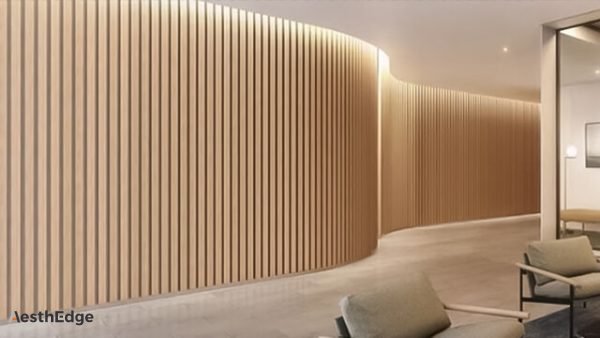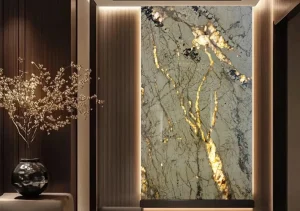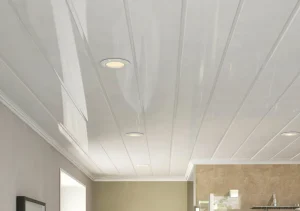Table of Contents
ToggleIntroduction
In the modern decoration industry, WPC (Wood Plastic Composite) ceiling panels have become one of the most popular choices for residential and commercial projects. They combine the warmth and texture of wood with the durability and low maintenance of plastic, creating a versatile material that fits a wide range of design styles.
As the demand for sustainable and long-lasting ceiling solutions grows, understanding the dimensions of WPC ceiling panels has become increasingly important. Panel size affects installation convenience, visual aesthetics, and overall cost efficiency. This article provides a detailed guide to common WPC ceiling panel dimensions, their applications, advantages, and market trends—helping importers, contractors, and designers make professional purchasing decisions.
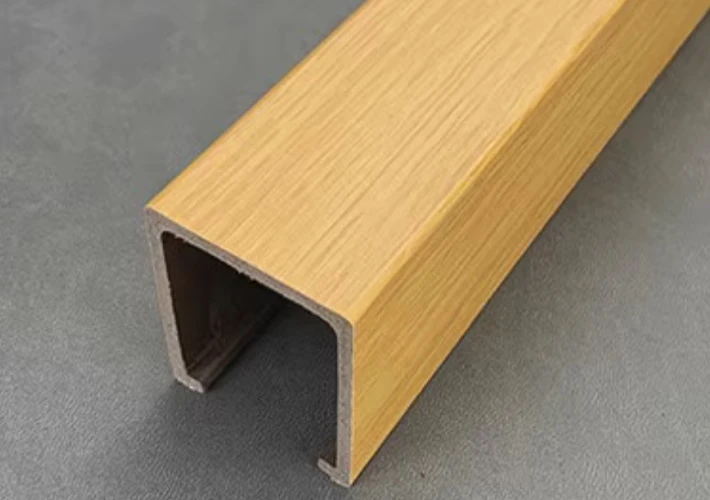
Overview of WPC Ceiling Panels
WPC ceiling panels are made from a composite of wood fibers and thermoplastic polymers such as PVC, PE, or PP. The materials are mixed, heated, and extruded into strong, lightweight panels with a natural wood appearance.
Key Features of WPC Ceiling Panels:
- Moisture and termite resistant – ideal for humid environments.
- Durable and weatherproof – does not crack, rot, or deform easily.
- Eco-friendly – uses recycled raw materials.
- Fire retardant – safer than traditional wood ceilings.
- Simple installation – click-lock and tongue-and-groove systems available.
- Low maintenance – easy to clean, no repainting required.
These features make WPC ceiling panels suitable for living rooms, kitchens, offices, hotels, and commercial spaces where both performance and aesthetics are essential.
Common Dimensions of WPC Ceiling Panels
The dimensions of WPC ceiling panels vary by manufacturer, but most factories follow international size standards to simplify installation and logistics.
(1) Common Widths
| Width | Description | Application |
|---|---|---|
| 150 mm (6 inches) | Slim panels with clear texture | Home ceilings, corridors |
| 200 mm (8 inches) | Balanced proportion | Residential and commercial ceilings |
| 250 mm (10 inches) | Fewer joints, modern look | Offices, lobbies |
| 300 mm (12 inches) | Wide coverage, clean visual | Hotels, restaurants |
| 400 mm (16 inches) | Large format, efficient installation | Malls, public buildings |
👉 Tip: Wider panels provide a seamless look and faster installation, while narrower panels give more texture and rhythm to small spaces.
(2) Common Thicknesses
| Thickness | Typical Use |
|---|---|
| 6 mm | Light-duty decoration |
| 8 mm | Most common for indoor use |
| 9–10 mm | Durable choice for offices or hotels |
| 12 mm | Heavy-duty, excellent sound insulation |
Thicker panels provide higher rigidity and noise reduction but also increase weight and cost slightly.
(3) Common Lengths
| Length | Typical Scenario |
|---|---|
| 2.9 m | Standard home ceilings |
| 3.0 m | Offices, small commercial areas |
| 3.6 m | Larger rooms and corridors |
| 5.8 m | Export standard (fits 20ft containers) |
Lengths between 2.9m–5.8m are most widely accepted for export, balancing efficiency and transport convenience.

How to Choose the Right Size of WPC Ceiling Panel
Choosing the correct dimension ensures both aesthetics and structural stability. Here are key factors to consider:
1.Room Size:
- Small rooms: 150–200 mm width recommended for a refined look.
- Large spaces: 250–400 mm width provides broad, seamless coverage.
2.Design Style:
- Narrow panels create a dynamic, detailed rhythm.
- Wide panels deliver modern simplicity and luxury.
3.Ceiling Height:
- For low ceilings, thinner panels (6–8 mm) reduce visual pressure.
- For high ceilings, thicker panels (10–12 mm) add depth and proportion.
4.Installation System Compatibility:
- Some click-lock systems require specific panel widths or thicknesses.
- Confirm matching trims, corner lines, and connectors before purchase.
5.Budget and Logistics:
- Longer panels save time but may increase freight costs.
- Standard lengths like 2.9m are more economical for shipping.
Common Surface Designs and Finishes
WPC ceiling panels are not only about size—they also come in various surface treatments and colors to meet aesthetic preferences.
Popular Surface Options:
- Wood Grain: Imitates oak, walnut, teak, or pine for a natural touch.
- Matte Finish: Minimalist, non-reflective look ideal for offices.
- Glossy Finish: Adds brightness and modern elegance.
- 3D Embossed: Provides texture and depth, enhancing ceiling character.
Surface finishing may slightly affect thickness (especially 3D embossed panels), but this variation is within acceptable tolerance levels.
Applications Based on Dimensions
Different WPC ceiling panel sizes are suited for specific environments.
| Application | Recommended Size | Remarks |
|---|---|---|
| Living Rooms | 200–300 mm width, 8–10 mm thick | Elegant and durable |
| Bathrooms | 150–200 mm width, 6–8 mm thick | Waterproof, mold-resistant |
| Offices | 250–300 mm width, 8–10 mm thick | Sleek and acoustic |
| Hotels & Restaurants | 300–400 mm width, 10–12 mm thick | Luxurious, sound-absorbing |
| Shopping Malls | 300–400 mm width, 12 mm thick | Sturdy and easy to maintain |
| Kitchens | 200 mm width, 8 mm thick | Resistant to moisture and oil stains |
Choosing panel dimensions according to the usage area ensures functional efficiency and visual balance.
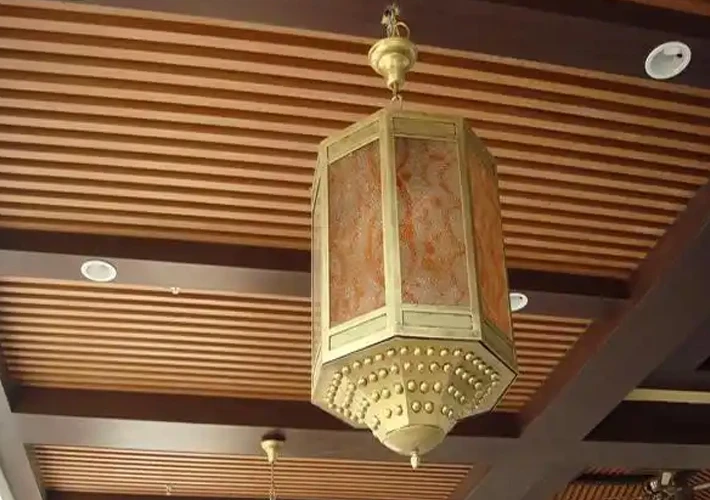
WPC Ceiling Panel vs. PVC Ceiling Panel
Many buyers compare WPC and PVC ceiling panels before making a purchase decision. While both are plastic-based materials, their structure and standard dimensions differ significantly.
| Feature | WPC Ceiling Panel | PVC Ceiling Panel |
|---|---|---|
| Composition | Wood fiber + plastic | 100% PVC |
| Width Range | 150–400 mm | 200–250 mm |
| Thickness Range | 6–12 mm | 5–8 mm |
| Durability | Strong, heavy-duty | Light, less impact resistant |
| Appearance | Natural wood effect | Glossy plastic finish |
| Eco-Friendliness | Recycled materials | Fully synthetic |
| Lifespan | 15–25 years | 8–15 years |
Thus, WPC ceiling panels are more suitable for mid- to high-end projects, where both design and longevity matter.
Market Trends and Global Demand
The global WPC ceiling panel market has experienced rapid growth, driven by sustainability trends and construction innovation.
Key Trends:
- Eco-friendly design: Global customers prefer recyclable, low-maintenance materials.
- Custom sizes: Importers increasingly request tailor-made dimensions for specific projects.
- Technological innovation: Extrusion and surface lamination technologies improve precision and aesthetics.
- Export dominance: China leads the WPC ceiling panel market with cost-effective production and strict quality control.
Market data shows that between 2020 and 2025, the demand for WPC decorative panels—including ceilings—has grown at an average annual rate of 8–10%.
For overseas buyers, Chinese suppliers offer flexible customization:
- Width: 100–400 mm
- Thickness: 6–20 mm
- Length: Up to 6 meters
- Surface options: Wood grain, marble, matte, embossed
Installation, Maintenance, and Lifespan
Installation Tips
- Narrow panels (150–200 mm): Require more clips but offer flexible layout options.
- Wide panels (300–400 mm): Faster installation, best for open areas.
- Long panels (5.8 m): Two-person handling recommended to avoid bending.
- Thicker panels (>10 mm): Pre-drilling or strong fixtures may be needed.
Maintenance Guidelines
WPC ceiling panels are nearly maintenance-free:
- Clean with a soft cloth and mild detergent.
- Avoid sharp tools or abrasive cleaners.
- Inspect joints annually to ensure secure fitting.
Lifespan
With proper installation and normal indoor conditions, WPC ceiling panels can last 15–25 years, maintaining their color, shape, and surface finish over time.
Conclusion
To summarize, the common dimensions for WPC ceiling panels are:
- Width: 150–400 mm
- Thickness: 6–12 mm
- Length: 2.9–5.8 m
Choosing the right panel size depends on your project type, room dimensions, installation method, and budget. Wider panels suit large, open spaces with a modern aesthetic, while narrow panels fit smaller rooms or intricate designs.
With excellent durability, easy installation, and customizable options, WPC ceiling panels are the ideal solution for modern interiors—offering the beauty of wood and the resilience of advanced composites.
For B2B buyers and distributors, working with an experienced WPC ceiling panel manufacturer in China ensures consistent quality, dimensional accuracy, and competitive pricing for global markets.

